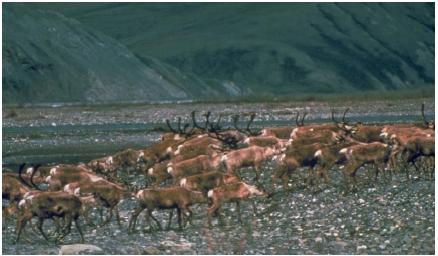Migration
In biology, the term migration refers to the regular, periodic movement of animals between two different places. Migration usually occurs in response to seasonal changes and is motivated by breeding and/or feeding drives. Migration has been studied most intensively among birds, but it is known to take place in many other animals as well, including insects, fish, whales, and other mammals. Migration is a complex behavior that involves timing, navigation, and other survival skills.
The term migration also applies to the movement of humans from one country to another for the purpose of taking up long-term or permanent residency in the new country.
Types of migration
Four major types of migration are known. In complete migration, all members of a population travel from their breeding habitat at the end of that season, often to a wintering site hundreds or even thousands of kilometers away. The arctic tern is an example of a complete migrant. Individuals of this species travel from the Arctic to the Antarctic and back again during the course of a year, a round-trip migration of more than 30,000 kilometers!
In other species, some individuals remain at the breeding ground year-round while other members of the same species migrate away. This phenomenon is known as partial migration. American robins are considered indicators of the arrival of spring in some areas but are year-round residents in other areas.
Differential migration occurs when all the members of a population migrate, but not necessarily at the same time or for the same distance. The differences are often based on age or sex. Herring gulls, for example, migrate a shorter and shorter distance as they grow older. Male American kestrels spend more time at their breeding grounds than do females, and when they do migrate, they don't travel as far.
Irruptive migration occurs in species that do not migrate at all during some years but may do so during other years. The primary factors determining whether or not migration occurs are weather and availability of food. For example, some populations of blue jays are believed to migrate only when their winter food of acorns is scarce.
Migration Pathways
Migratory animals travel along the same general routes each year. Several common "flyways" are used by North American birds on their southward journey. The most commonly used path includes an 800 to 1,100 kilometer flight southward across the Gulf of Mexico. In order to survive this difficult journey, birds must store extra energy in the form of fat. All along the migration route, but particularly before crossing a large expanse of water, birds rest and eat, sometimes for days at a time. The

birds start out again on their journey only when they have added a certain amount of body fat.
Although most migrants travel at night, a few birds prefer daytime migrations. The pathways used by these birds tend to be less direct and slower than those of night migrants, primarily because of differences in feeding strategies. Night migrants can spend the day in one area foraging for food and building up energy reserves for the night's nonstop flight. Daytime migrants must combine travel with foraging, and thus tend to keep to the shorelines, which are rich in insect life, capturing food during a slow but ever-southward journey.
Navigation
Perhaps the most remarkable aspect of migration is the navigational skills employed by the animals. Birds such as the albatross and lesser golden plover travel hundreds of kilometers over the featureless open ocean. Yet they arrive home without error to the same breeding grounds year after year. Salmon migrate upstream from the sea to the very same freshwater shallows in which they were hatched. Monarch butterflies began life in the United States or Canada. They then travel to the same wintering grounds in Southern California or Mexico that had been used by ancestors many generations before.
How are these incredible feats of navigation accomplished? Different animals have been shown to use a diverse range of navigational aids, involving senses often much more acute than our own. Sight, for example, may be important for some animals' navigational skills, although it may often be secondary to other senses. Salmon can smell the water of their home rivers, and follow this scent all the way from the sea. Pigeons also sense wind-borne odors and may be able to organize the memories of the sources of these smells in a kind of internal map. It has been shown that many animals have the ability to sense the magnetic forces associated with the north and south poles, and thus have their own built-in compass. This magnetic sense and the sense of smell are believed to be the most important factors involved in animal migration.
Comment about this article, ask questions, or add new information about this topic: